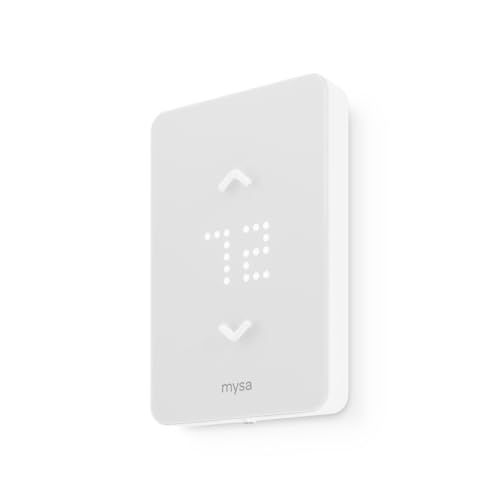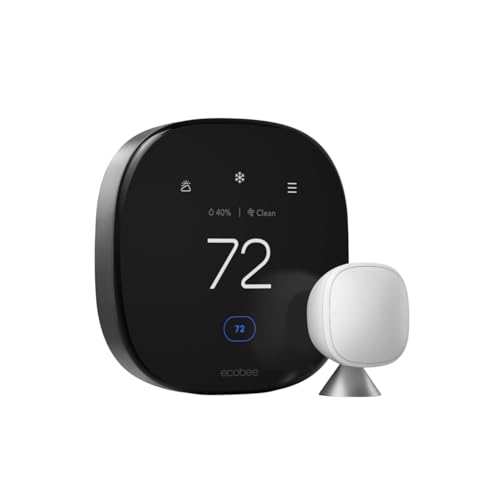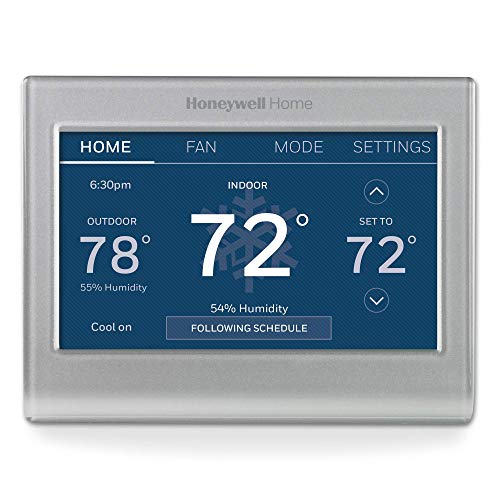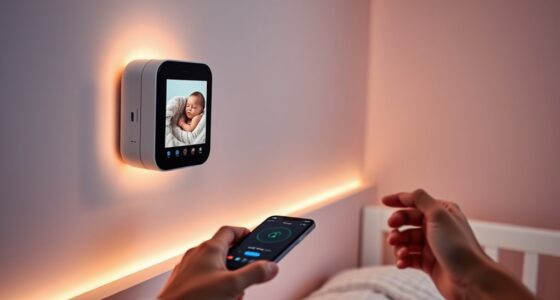If you’re looking for the best smart thermostats for heat-only systems, I’ve found options like the Sensi and ecobee models that offer easy installation, energy savings, and smart home compatibility. Many support Wi-Fi control, voice commands, and detailed scheduling to keep your home cozy and efficient. Some are designed specifically for electric baseboards or floor heating, ensuring safety and reliable performance. Keep going to discover all the top choices tailored to your heating system needs.
Key Takeaways
- These thermostats are designed specifically for heat-only systems, ensuring efficient and reliable home heating control.
- They support various wiring configurations, including C-wires and power extender kits, for easy DIY installation.
- Many models offer energy-saving features like scheduling, occupancy sensors, and remote control to reduce heating costs.
- Compatibility with smart home platforms (Alexa, Google Assistant, Apple HomeKit) allows seamless voice and automation integration.
- Key safety and performance features include GFCI protection, accurate sensors, and user-friendly interfaces for cozy, efficient heating.
Sensi Smart Thermostat
If you’re looking for a reliable and easy-to-install smart thermostat for your heat-only system, the Sensi Smart Thermostat (Model ST55) is an excellent choice. It features Wi-Fi connectivity, mobile app control, and works with most HVAC systems without needing a common wire. Its design mimics traditional thermostats, fitting standard wall space seamlessly. Sensi offers energy savings of around 23%, along with flexible scheduling and remote access to optimize comfort and efficiency. Plus, it monitors system performance, provides maintenance alerts, and emphasizes data privacy. Overall, Sensi combines straightforward setup, user-friendly controls, and smart features, making it a top pick for heat-only systems.
Best For: homeowners with heat-only HVAC systems seeking an easy-to-install, energy-efficient smart thermostat that offers remote control and reliable system monitoring.
Pros:
- Easy to install with step-by-step instructions and no common wire needed in many cases
- Helps reduce energy costs by approximately 23% with flexible scheduling and remote access
- Monitors HVAC performance and provides maintenance alerts to prolong system lifespan
Cons:
- Limited to heat-only systems, not suitable for cooling or multi-zone setups
- Design is similar to traditional thermostats, which may lack modern aesthetic appeal for some users
- Compatibility may vary depending on specific HVAC configurations and wiring requirements
Sensi Lite Smart Thermostat
The Sensi Lite Smart Thermostat stands out as an excellent choice for homeowners seeking an easy-to-install, Wi-Fi-enabled thermostat that offers significant energy savings. I appreciate its simple DIY setup, thanks to the built-in level and clear instructions. It’s compatible with most HVAC systems, though a C-wire is needed for heat pump and heat/cool setups. With features like flexible scheduling, geofencing, and remote control via a user-friendly app, it helps save around 23% on energy costs. Plus, it’s Energy Star certified and prioritizes privacy, ensuring my data isn’t sold or used for targeting. Overall, it combines convenience, efficiency, and security effortlessly.
Best For: homeowners seeking an easy-to-install, Wi-Fi-enabled thermostat that offers energy savings and remote control capabilities.
Pros:
- Simple DIY installation with built-in level and step-by-step instructions
- Compatible with most HVAC systems, including programmable and Wi-Fi-enabled features
- Helps save approximately 23% on energy costs through flexible scheduling and geofencing
Cons:
- Requires a C-wire for heat pump and heat/cool only systems, which may not be available in all homes
- Not compatible with heat/cool systems that do not support Wi-Fi or are non-programmable
- Limited to systems compatible with the Sensi Lite model, excluding some specialized HVAC setups
Schluter Ditra-Heat-E-RS1 Smart Thermostat with Floor Sensors
For homeowners seeking precise control over their floor heating, the Schluter Ditra-Heat-E-RS1 Smart Thermostat with Floor Sensors stands out as an excellent choice. It seamlessly integrates with home automation systems and voice assistants, allowing easy control via app or voice commands. Compatible with 120V and 240V DITRA-HEAT-E-HK cables, it supports up to 15 amps, with an optional power module for larger systems. The thermostat offers energy tracking to help reduce costs and features a class A GFCI for safety. Backed by a 3-year warranty, it’s a reliable, smart solution for maintaining a cozy, energy-efficient home.
Best For: homeowners seeking precise, energy-efficient control of floor heating with seamless smart home integration and safety features.
Pros:
- Compatible with 120V and 240V DITRA-HEAT-E-HK cables supporting up to 15 amps
- Integrates easily with home automation systems and voice assistants for convenient control
- Includes energy tracking via a user-friendly app to monitor and reduce heating costs
Cons:
- Requires adherence to Schluter installation guidelines and industry standards for warranty validity
- May need an additional power module for larger heating systems, increasing setup complexity and cost
- Dependence on app or voice control may be less ideal for users preferring manual operation
ecobee Smart Thermostat Enhanced
Designed for those seeking energy-efficient and smart home-compatible heating control, the ecobee Smart Thermostat Enhanced stands out with its extensive compatibility and advanced features. It works with popular voice assistants like Siri, Alexa, and Google Assistant, as well as Apple HomeKit, SmartThings, and IFTTT. Compatible with 90% of HVAC systems, it’s suitable for gas, electric, oil, heat pumps, and boilers. The sleek black design, LCD display, and easy installation—including a Power Extender Kit—make it user-friendly. With energy-saving features that cut costs by up to 26%, occupancy sensors, and remote control options, it offers comfort and efficiency at your fingertips.
Best For: homeowners seeking a versatile, energy-efficient smart thermostat compatible with a wide range of HVAC systems and smart home platforms.
Pros:
- Compatible with 90% of HVAC systems, including gas, electric, oil, heat pumps, and boilers
- Features energy-saving functions that can reduce heating and cooling costs by up to 26%
- Seamless integration with popular voice assistants and smart home ecosystems like Siri, Alexa, Google Assistant, and Apple HomeKit
Cons:
- Installation may require professional help if no C-wire is available, due to wiring complexities
- Initial setup can be challenging for users unfamiliar with wiring and smart thermostats
- Some compatibility issues reported with complex or older HVAC systems, potentially leading to returns or upgrades
Amazon Smart Thermostat
If you’re looking to upgrade your heat-only system with a smart thermostat that’s easy to install and use, the Amazon Smart Thermostat is an excellent choice. It’s compatible with Alexa and Ring devices, making integration seamless. You’ll need a C-wire for installation, but the Alexa app provides step-by-step guidance. Built with Honeywell technology and backed by 130 years of experience, it offers reliable performance. Certified ENERGY STAR, it can save you around $50 annually on energy bills. Plus, you can manage it remotely via the Alexa app, and Alexa automatically adjusts temperatures based on your routines or presence, ensuring comfort and efficiency.
Best For: homeowners seeking an easy-to-install, reliable smart thermostat compatible with Alexa and Ring to optimize energy savings and convenience.
Pros:
- Seamless integration with Alexa and Ring devices for smart home compatibility
- Energy Star certified, helping save approximately $50 annually on energy bills
- User-friendly with step-by-step installation guidance via the Alexa app and remote management options
Cons:
- Requires a C-wire for installation, which may not be present in all homes
- Compatibility limited to systems with Honeywell technology, possibly excluding some HVAC setups
- Dependence on Wi-Fi connectivity for remote control and automation features
Mysa Smart Thermostat LITE for Electric Baseboard Heaters
The Mysa Smart Thermostat LITE stands out as an excellent choice for homeowners with electric baseboard heaters who want easy, DIY installation and precise control. Designed for 120V-240V systems, it’s compatible with baseboard, fan-forced, wall, and convector heaters. Installation takes about 15 minutes with a simple 4-wire setup, no electrician needed. The sleek design, WiFi connectivity, and compatibility with Apple HomeKit, Alexa, and Google Assistant make remote control effortless. You can create custom schedules, monitor energy usage, and reduce costs by up to 26%. Plus, the free Mysa app offers all features without hidden fees, making this thermostat both practical and user-friendly.
Best For: homeowners with electric baseboard heaters seeking an easy DIY installation, precise remote control, and energy savings.
Pros:
- Simple 4-wire DIY installation, no electrician needed, approximately 15 minutes setup
- Compatible with popular smart home platforms like Apple HomeKit, Alexa, and Google Assistant
- Free Mysa app offers comprehensive features including scheduling, energy monitoring, and remote control without hidden fees
Cons:
- Designed specifically for 120V-240V electric baseboard and similar heaters, not suitable for other heating types
- May require WiFi connectivity for full feature access; limited functionality offline
- Limited physical controls on the thermostat itself, relying on app and voice commands for adjustments
ecobee Smart Thermostat Premium with Sensor and Air Quality Monitor
For homeowners seeking premium features, the ecobee Smart Thermostat Premium with Sensor and Air Quality Monitor stands out as an ideal choice. It can save up to 26% annually on heating and cooling costs and is ENERGY STAR certified. The included SmartSensor adjusts temperature in key rooms, reducing hot or cold spots for consistent comfort. It also monitors indoor air quality, detects poor conditions, and alerts you to change filters. Additionally, it acts as a home security hub with smoke detection and break-in alerts. Its sleek design, vibrant display, and voice control support make it a versatile, efficient, and stylish upgrade for your heat-only system.
Best For: homeowners seeking a premium, energy-efficient smart thermostat with advanced air quality monitoring, security features, and sleek design for their heating system.
Pros:
- Saves up to 26% annually on heating and cooling costs, lowering energy bills
- Built-in air quality monitor and filter change reminders improve indoor environment health
- Acts as a home security hub with smoke detection and break-in alerts, enhancing safety
Cons:
- Requires a subscription for full security and monitoring features
- Compatibility limited to most 24VAC HVAC systems; may not suit all setups
- Apple home hub needed for Siri voice control, adding extra equipment for Apple users
Honeywell Home Smart Thermostat, WiFi compatible
The Honeywell Home Smart Thermostat, WiFi compatible, stands out as an excellent choice for homeowners seeking seamless integration with popular smart home platforms like Amazon Alexa, Google Assistant, and Apple HomeKit. Designed for conventional and heat pump systems, it offers flexible scheduling, auto-away, and demand response features that help save energy. The thermostat supports app control, voice commands, and has an LCD display with customizable options. Setup is straightforward if you have a C-wire, though some connectivity issues may occur initially. Overall, it’s a reliable, user-friendly device that combines smart features with practical heat-only system control, backed by a 2-year warranty.
Best For: homeowners seeking a reliable, WiFi-enabled smart thermostat compatible with popular voice assistants and smart home platforms, especially those with conventional or heat pump systems.
Pros:
- Supports seamless integration with Amazon Alexa, Google Assistant, and Apple HomeKit for versatile voice control.
- Easy to install and set up, especially with existing C-wire connections, and offers flexible scheduling and auto-away features.
- ENERGY STAR certified with demand response capabilities, helping to save energy and qualify for rebates.
Cons:
- Some users experience initial WiFi connectivity issues requiring troubleshooting or enabling location services.
- App interface may be limited with small text and horizontal scrolling, which can affect user experience.
- Lacks advanced features like remote sensors and may require technical knowledge for optimal integration with certain smart home systems.
Mysa Smart Thermostat for Electric Baseboard Heaters
If you have high-voltage electric baseboard heaters and want a smart thermostat tailored for them, the Mysa Smart Thermostat stands out as an excellent choice. It’s designed specifically for 120–240V electric baseboards and fan-forced heaters, supporting loads up to 1900W at 120V and 3800W at 240V. The device requires at least four wires, including a neutral or second live wire, so check compatibility before installing. Its compact size, adaptive display, and Wi-Fi connectivity make remote control easy. Plus, it integrates seamlessly with Alexa, Google Assistant, and Apple HomeKit, offering convenient, energy-efficient heating management right from your smartphone.
Best For: homeowners with high-voltage electric baseboard heaters seeking a compact, Wi-Fi-enabled smart thermostat compatible with popular voice assistants.
Pros:
- Supports high/line voltage electric baseboards up to 3800W at 240V for versatile application
- Seamless integration with Alexa, Google Assistant, and Apple HomeKit for hands-free control
- Compact design with adaptive display technology for optimal visibility and user comfort
Cons:
- Requires at least four wires, including a neutral or second live wire, limiting compatibility with some older systems
- Not suitable for low-voltage or two-wire installations, restricting installation options
- May require professional installation to ensure proper wiring and compatibility
SunTouch SunStat CommandPlus Touchscreen Thermostat for Electric Floor Heating
The SunTouch SunStat CommandPlus stands out as an excellent choice for homeowners seeking precise control over electric floor heating systems, thanks to its advanced touchscreen interface and Wi-Fi connectivity. Its sleek 4.3-inch display makes programming straightforward, with features like a 7-day schedule, SmartStart, and weather display enhancing convenience. The thermostat offers accurate temperature regulation through floor and air sensing controls, plus energy monitoring and ‘away’ mode to save power. Remote access via the Watts Home app means you can adjust settings anytime, anywhere. Installation is simple, and its modern design adds a sophisticated touch to any space, ensuring comfort and efficiency.
Best For: homeowners and property managers seeking precise, customizable control of electric floor heating with modern features and remote accessibility.
Pros:
- Intuitive 4.3-inch touchscreen interface for easy programming and control
- Wi-Fi connectivity with remote access via the Watts Home app for convenience
- Accurate temperature regulation with floor and air sensing controls
Cons:
- Connecting fine sensor wires may require careful handling during installation
- Some users note that larger text on the display could improve visibility
- Occasional shipping damages or difficulty separating the screen from the base have been reported
ecobee Smart Thermostat Essential – Wi-Fi Programmable Thermostat
Designed for homeowners seeking an easy-to-install, energy-efficient thermostat, the ecobee Smart Thermostat Essential stands out with its compatibility with 85% of HVAC systems and built-in Wi-Fi for remote control. It’s Energy Star certified and works seamlessly with Siri, Alexa, and Google Assistant. You can save up to 23% annually on heating and cooling, often recouping the cost within six months. Installation is straightforward, often taking about 20 minutes, with no C-wire needed if you use the Power Extender Kit. Its user-friendly app and touch interface make scheduling, adjustments, and monitoring simple, giving you reliable control from anywhere.
Best For: homeowners seeking an easy-to-install, energy-efficient thermostat that works with multiple smart home platforms and offers remote control capabilities.
Pros:
- Compatible with 85% of HVAC systems, including various fuel types and heat pump setups
- Easy DIY installation with no C-wire required when using the Power Extender Kit
- Energy savings of up to 23% annually, often recouping the device cost within six months
Cons:
- Some users experience wiring challenges during installation
- Customer support may be difficult to reach or less responsive
- Additional components like cover plates may be needed for wall aesthetics
Schluter Ditra-Heat-E-WiFi Thermostat with Floor Sensor
For homeowners seeking precise control over their floor heating, the Schluter Ditra-Heat-E-WiFi Thermostat with Floor Sensor stands out thanks to its seamless smart home integration and remote management capabilities. It’s compatible with both 120V and 240V systems, supporting up to 15 amps, and offers a programmable touchscreen and app-based control. The thermostat tracks energy use, helping you optimize costs, while its built-in GFCI guarantees safety by preventing shocks. Easy to install with proper guidelines, it also integrates effortlessly with home automation and voice assistants, making it a reliable, efficient choice for maintaining a cozy, energy-smart home.
Best For: homeowners seeking precise, remotely controllable floor heating management with smart home integration and safety features.
Pros:
- Compatible with both 120V and 240V systems supporting up to 15 amps.
- Offers app control and programmable touchscreen for easy customization.
- Includes energy monitoring and a built-in GFCI for safety.
Cons:
- Requires proper installation following specific guidelines for warranty validity.
- Additional power module needed for larger heating systems.
- May be limited in advanced automation features depending on home system compatibility.
Schluter Ditra-Heat-E-RT Thermostat with Ground Fault Circuit Interrupter
If you’re seeking a thermostat that prioritizes safety and precise control for your home floor heating system, the Schluter Ditra-Heat-E-RT stands out. This programmable touchscreen device offers a clear 3.5-inch display, making it easy to set schedules and monitor energy use. Compatible with Ditra-Heat-E-HK cables, it supports both 120V and 240V power. Its built-in Ground Fault Circuit Interrupter (GFCI) adds an extra layer of safety by preventing electrical hazards. With accurate floor temperature regulation via a sensor and energy tracking features, it ensures efficient, safe, and comfortable heating, making it a reliable choice for any heat-only system.
Best For: homeowners seeking a safe, user-friendly, and energy-efficient thermostat for their residential floor heating systems.
Pros:
- High-resolution touchscreen display with intuitive controls for easy scheduling and adjustments
- Built-in GFCI enhances safety by preventing electrical hazards during operation
- Supports multiple power options (120V and 240V) and integrates with Schluter’s heating cables for reliable performance
Cons:
- Some users have experienced product failures within a year, citing quality and durability concerns
- Does not include temperature sensors, requiring separate purchase for accurate floor temperature regulation
- Limited customer support reported by a few users regarding warranty claims and troubleshooting
RTH9585WF1004 Wi-Fi Smart Color Thermostat
The RTH9585WF1004 Wi-Fi Smart Color Thermostat stands out for its customizable color options and intuitive touchscreen, making it an excellent choice for homeowners seeking both style and smart control. Its bright, easy-to-read display simplifies programming with a 7-day schedule and flexible options for peak energy rates. Compatible with various forced air heating systems, it supports energy-saving features like monthly reports and personalized tips. Being ENERGY STAR certified, it helps reduce energy consumption. Plus, it’s Alexa-ready and allows enrollment in utility demand response programs, offering potential rebates and rewards. Just verify your system has a C-wire before installing.
Best For: homeowners seeking a stylish, customizable, and energy-efficient smart thermostat compatible with various forced air heating systems.
Pros:
- Personalizable color options and an intuitive touchscreen for easy operation
- ENERGY STAR certified, supporting energy savings and offering potential rebates
- Compatible with Alexa and utility demand response programs for added convenience and rewards
Cons:
- Requires a C-wire for power; compatibility should be verified before installation
- Not suitable for electric baseboard heating systems (120-240V)
- Limited to forced air, hot water, steam, and heat pump systems with electric backup
Sensi Touch 2 Smart Thermostat with Touchscreen
With its vibrant 5.6-inch color touchscreen and seamless smart home integration, the Sensi Touch 2 Smart Thermostat stands out as an excellent choice for homeowners seeking a user-friendly, heat-only control system. It supports heating and cooling control, works with Alexa, Google Assistant, and Samsung SmartThings, and integrates easily with home automation platforms. Designed for DIY installation, it offers flexible scheduling, remote control, and energy-saving features like usage reports and alerts. Its sleek black design and intuitive app make adjustments simple, while compatibility with most HVAC systems ensures it fits a wide range of homes. Plus, it’s Energy Star certified, emphasizing efficiency and reliability.
Best For: homeowners seeking an easy-to-install, user-friendly smart thermostat with robust voice control and energy-saving features.
Pros:
- Intuitive 5.6-inch full-color touchscreen display for effortless control
- Compatible with Alexa, Google Assistant, and Samsung SmartThings for seamless smart home integration
- Supports flexible scheduling, remote access, and energy monitoring to enhance comfort and efficiency
Cons:
- Requires a c-wire for installation, which may not be present in all homes
- Initial Wi-Fi setup can be challenging, with potential pin code issues during connection attempts
- Limited compatibility with older HVAC systems that lack standard wiring
Factors to Consider When Choosing Smart Thermostats for Heat‑Only Systems

When choosing a smart thermostat for heat-only systems, I always consider compatibility with my heating setup to avoid issues later. I also look at wiring and power needs to ensure a smooth installation, and I pay attention to temperature control accuracy for consistent comfort. Finally, I evaluate how well it integrates with my existing smart home devices and how complex the installation process might be.
Compatibility With Heating Systems
Choosing a smart thermostat for your heat-only system requires careful attention to compatibility. First, confirm the thermostat supports your system’s type, whether it’s a furnace, boiler, or electric baseboard heater, which usually operate on 24V or line voltage. Check the voltage and wiring requirements—some thermostats are designed specifically for low-voltage (24V) systems, while others handle line-voltage (120V or 240V). It’s also essential to verify that the thermostat can handle your system’s maximum load to avoid overloads or safety issues. If your setup includes features like heat priority modes, floor sensors, or multi-stage heating, confirm the thermostat supports these functions. Always review the manufacturer’s specifications to ensure compatibility with your specific heating system before installation.
Wiring and Power Needs
Proper wiring and power supply are key to ensuring your smart thermostat works reliably with a heat-only system. Most require a dedicated C-wire or an alternative power source to maintain consistent operation. Many models need a 24V AC connection to function correctly, making wiring compatibility essential. If your system lacks a C-wire, some thermostats offer Power Extender Kits or similar solutions, but installation can be more complex. Without proper wiring or sufficient power, you risk connectivity issues, inaccurate temperature control, or system shutdowns. To avoid these problems, verify your system’s wiring setup and power needs before purchasing. Ensuring compatibility upfront helps prevent installation headaches and guarantees your smart thermostat operates smoothly, keeping your home cozy and energy-efficient.
Temperature Control Accuracy
Accurate temperature control is essential for maintaining consistent comfort and avoiding energy waste in heat-only systems. The precision of a thermostat’s sensor and its calibration directly influence how well it maintains your desired temperature. High-quality thermostats often feature multiple sensors or remote room sensors, which help ensure more even temperature distribution across different zones. A good thermostat can typically keep the temperature within ±0.5°F, providing precise climate control. Proper placement of the thermostat is also critical—avoid spots with drafts, direct sunlight, or near heat sources, as these can skew readings and reduce accuracy. When choosing a smart thermostat, look for models with proven sensor accuracy and reliable calibration to keep your home cozy and energy-efficient.
Integration With Smart Home
To get the most out of your heat-only system, it’s important to select a smart thermostat that seamlessly integrates with your existing smart home setup. I recommend checking compatibility with your preferred voice assistants like Alexa, Google Assistant, or Apple HomeKit to enable effortless voice control and app management. It’s also beneficial if the thermostat can connect with other smart devices, such as sensors or security systems, to improve automation and energy savings. Make sure it supports remote access via a dedicated mobile app so you can control your heat from anywhere. Compatibility with your specific heat system—whether it’s forced air or a boiler—is essential to avoid installation issues. Finally, features like scheduling, geofencing, and occupancy sensing can optimize heating efficiency within your smart home ecosystem.
Installation Complexity Level
Choosing the right smart thermostat for your heat-only system depends heavily on how easy or complex the installation process will be. Some models require a common wire (C-wire), which can make installation more involved if your existing wiring lacks one. Others support power sharing or wireless power, simplifying setup but possibly limiting features. Many thermostats are designed for DIY installation with step-by-step instructions, yet some systems may need professional wiring or electrical modifications, increasing complexity and costs. Additional sensors, integration with existing HVAC wiring, and the need for wiring changes all influence difficulty. Simplified models with built-in power sharing or batteries tend to be easier to install but might have compatibility restrictions. Assess your existing wiring and comfort level to choose a thermostat that matches your installation skills.
Energy Saving Features
Energy-saving features are essential when selecting a smart thermostat for your heat-only system, as they directly impact your home’s efficiency and your energy bills. Look for models with flexible scheduling and geofencing so your system adjusts based on occupancy, reducing unnecessary heating. Detailed energy reports and usage analytics help you identify waste and optimize your settings. Built-in outdoor sensors or compatible ones allow accurate temperature adjustments and prevent energy drain. Automatic temperature adjustments and adaptive learning fine-tune your system’s performance over time, maximizing efficiency. Additionally, remote access via mobile apps lets you monitor and control your heating from anywhere, ensuring you don’t waste energy when you’re away. Focusing on these features will help you save money and keep your home cozy.
Frequently Asked Questions
Can These Thermostats Control Multiple Heat Zones Simultaneously?
Yes, many smart thermostats can control multiple heat zones simultaneously. I’ve installed models that allow me to manage different areas of my home independently, which saves energy and keeps every room comfortable. These thermostats often come with a zoning kit or multiple thermostats linked to a central hub, making it easy to customize temperature settings for each zone. It’s a game-changer for maintaining coziness and efficiency throughout my house.
Are There Compatibility Issues With Older Heating Systems?
Yes, compatibility can be an issue with older heating systems. I always recommend checking the thermostat’s suitability before purchasing. Some older systems might lack the necessary wiring or control features. I suggest consulting the thermostat’s manual or a professional installer to ensure it will work with your specific setup. Doing this avoids surprises and helps you enjoy a cozy, efficient home without any technical hiccups.
How Secure Is the Wi-Fi Connection for Remote Access?
They say “trust, but verify,” and I believe that applies to Wi-Fi security too. My remote access is quite secure; most smart thermostats use encrypted connections and two-factor authentication. I always keep my firmware updated and use strong, unique passwords. While no system is foolproof, these measures give me peace of mind knowing my home’s heating controls are protected from unauthorized access.
Do These Thermostats Support Voice Control Integrations?
Yes, most of these thermostats support voice control integrations. I can control my thermostat using voice commands through platforms like Amazon Alexa, Google Assistant, or Apple HomeKit. It’s super convenient because I don’t have to get up or open an app. Just a simple voice command adjusts my heat, making my home cozy and ensuring I stay comfortable without any hassle.
What Is the Typical Installation Process for Each Model?
The installation process varies by model but generally involves turning off power, removing the old thermostat, and connecting the new one’s wires to the corresponding terminals. I recommend reading the manufacturer’s instructions carefully and, if unsure, consulting a professional. Most models come with detailed guides or apps that walk you through each step. With patience and care, I find installation straightforward and rewarding, ensuring your system runs efficiently.
Conclusion
Choosing the right smart thermostat can truly transform your home’s comfort and efficiency. Imagine setting your heat just right, even from your phone while on a weekend getaway. For example, Sarah installed an ecobee and now easily adjusts her heat, saving energy and money. Whatever system you choose, a smart thermostat makes managing your heat simple and smart—giving you cozy warmth exactly when you need it, without wasting energy.

























